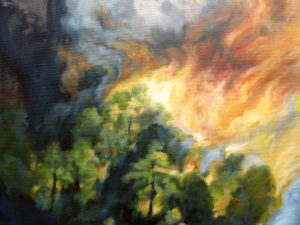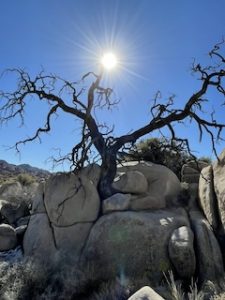 The Columbia City Yoga on-line Moving into Meditation class met this morning. The heartbreaking events of the past week’s catastrophic fires have shown that our survival depends on how we help one another. We also reflected on the inner resources of balance and equanimity. Cultivating inner balance can help to see and think clearly. It can help us to sustain our support and service efforts.
The Columbia City Yoga on-line Moving into Meditation class met this morning. The heartbreaking events of the past week’s catastrophic fires have shown that our survival depends on how we help one another. We also reflected on the inner resources of balance and equanimity. Cultivating inner balance can help to see and think clearly. It can help us to sustain our support and service efforts.
We heard Terry Tempest Williams‘ powerful essay after the 2020 Utah fire season. Over 330,000 acres burned in Terry’s homeland. The essay is called A Burning Testament. I think it speaks to our current western wildfire season.
We heard from Oren Jay Sofer’s book: Your Heart Was Made for This: Contemplative Practices for Meeting a World in Crisis with Courage, Integrity, and Love. Oren writes about equanimity as a centering stabilizing resource in our lives. It enables us to stay right on the edge of reactivity. We stay long enough to gain perspective and consider an appropriate response.
Our guided mediation was inspired by mediation teacher Kelly Boys‘ teachings on non-sleep deep rest (NSDR). You can find more of Kelly’s practices on the Alembic YouTube channel Kelly Boys Playlist.
Welcome. Last week we reflected on our human need for help. We give and receive help during the course of our lives. The heartbreaking events of the past week’s catastrophic fires have shown that our survival depends on how we help one another. Many of us have friends and family who have been in harms way or very close to it. The dangers of breathing the chemicals carried by the smoke will touch untold numbers of people. This week I observed my own reactivity as I witnessed what was happening to friends, family and so many others. I could feel it in my body and observe it in my behavior. This looked like a lot of screen time, news gathering and reaching out to others.
One of my literary heroes, Utah native Terry Tempest Williams, wrote a powerful essay after the 2020 Utah fire season. Over 330,000 acres burned in Terry’s homeland. The essay is called A Burning Testament. I think it speaks to our current western wildfire season. Terry writes:
We are witness to ghostly horizons lit with the scalding colors of, red, orange, purple, black, the . . . acres of land being ravaged by fires with such velocity it is melting our capacity to feel the full magnitude of what is happening – We are not okay.
We are anxious. We are scared. There is no place to run. There is no place to hide. There is only our love and grief to hold us in the terror of all we are seeing, sensing, denying. . . .
. . . We are saying farewell to what we love and why we stay. How can we stay? The landscape of the American West is burning and we are burning, too. . . .
To the power of these burning, illuminated western lands who have shaped our character, inspired our souls, and restored our belief in what is beautiful and enduring . . . even as you burn, you are throwing down seeds that will sprout and flower, trees will grow, and forests will rise again as living testaments to how one survives change.
Terry’s Testament grips my heart. “We are not okay. We are anxious. We are scared. There is no place to run. There is no place to hide. In the anguish of worrying from afar – I cling to the love and grief that holds us.
Our practice can help us find the strength and spiritual will to bear witness. We keep our hearts open to the world around us in all its beauty and devastation.
In grieving the lives of humans and more than humans we can remember that the seeds of renewal are in our response. Our grief is an expression of love – love that includes future generations. We can begin the work of restoration today in the many small and large ways we care for one another.
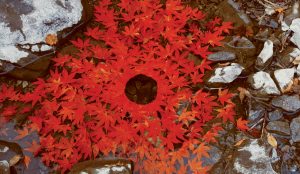 Our practice can help us cultivate equanimity, compassion and wisdom. We will need these qualities in the caring work of restoration. Equanimity can help us to calm our nervous systems so we can think clearly. Slow time in loving awareness can help the heart to open and the mind to clear. Like patience, equanimity can help us “learn to let go of things we can’t control and find balance.” Oren Jay Sofer writes about equanimity in his book: Your Heart Was Made for This: Contemplative Practices for Meeting a World in Crisis with Courage, Integrity, and Love.
Our practice can help us cultivate equanimity, compassion and wisdom. We will need these qualities in the caring work of restoration. Equanimity can help us to calm our nervous systems so we can think clearly. Slow time in loving awareness can help the heart to open and the mind to clear. Like patience, equanimity can help us “learn to let go of things we can’t control and find balance.” Oren Jay Sofer writes about equanimity in his book: Your Heart Was Made for This: Contemplative Practices for Meeting a World in Crisis with Courage, Integrity, and Love.
Equanimity connects intimately with life. . . giving the perspective to see a bigger picture, enough space to include all that we experience. . . . A wise heart knows the truth: conditions change without end. The more deeply we understand this, the less agitated we grow when things fall apart or change unexpectedly. We discover . . a spacious and grounded openness. Equanimity steadies us like the keel of a ship at sea. Storms may shake us but we don’t capsize.
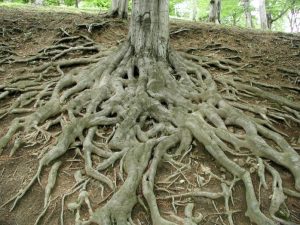 Let’s explore mindfulness as a way of calming our nervous systems and cultivating balance and equanimity. You might want to lie down for this experience. I invite you to take some time to find your center of gravity. Relax whatever you can into Earth’s support.
Let’s explore mindfulness as a way of calming our nervous systems and cultivating balance and equanimity. You might want to lie down for this experience. I invite you to take some time to find your center of gravity. Relax whatever you can into Earth’s support.
We’re going to explore the dimension of being that can emerge with the practice of meditation: an unshakable steadiness no matter the circumstances. The waves of life will naturally affect us. When we embody balanced being it helps us to access a dimension of consciousness that is a resource for us.
Allow your eyes to close or relax. Rest your arms and hands where they feel comfortable. You might sense the space around you. Feel your body settling within that space.
 As you’re ready rest your attention on the feeling of breathing. Begin breathing in for a count of 2 and out for a count of 2. Follow the count of your breath as you establish even breathing. In – 1, 2 and Out – 1,2. You can invite a sense of steadiness and groundedness and you breathe in – 2 and out – 2.
As you’re ready rest your attention on the feeling of breathing. Begin breathing in for a count of 2 and out for a count of 2. Follow the count of your breath as you establish even breathing. In – 1, 2 and Out – 1,2. You can invite a sense of steadiness and groundedness and you breathe in – 2 and out – 2.
Notice however you feel right now. What ever is present. Notice with kind, curious attention.
As you continue breathing in and out in this way, we’ll add body sensing to embody the quality of balance. On the next in-breath feel the whole front side of the body; on the out-breath feeling the whole backside of the body. Breathing in – front. Breathing out – back. So continue to sense in this way at your own count.
If you don’t want to count, no problem simply follow the breath in and out.
Next we’ll do left and right side. On the inhale feel the left side. On the exhale fee the right side. This is the sensation in the body as you’re breathing. The whole left side of the body on the next inhale and the whole right side of the body on the Go back and forth.
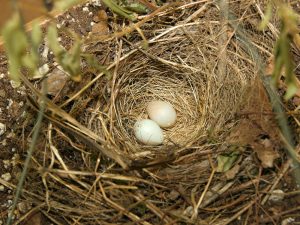 As you’re breathing in and out, can you feel this inner steadiness, this inner balance as you sense the left and right sides of the body? Perhaps returning to the front side and then the back side. Breathing in. Breathing out.
As you’re breathing in and out, can you feel this inner steadiness, this inner balance as you sense the left and right sides of the body? Perhaps returning to the front side and then the back side. Breathing in. Breathing out.
Now let go of the body sensing and continue this even breathing. Breathing in for 2 and out for 2 feeling an inner sense of balance. . . . Trust your own breathing. This doesn’t need to be precise. We’re simply following the breath in and following the breath out. . . .
Consider any moments of activation. The ruffling of the nervous system that happens when the waves of life are rocking you or the storms are passing over the mountain. Notice and welcome any of these movements of life and simultaneously feel this inner sense of balance and equanimity. There is something deeper that is not affected, not ruffled. Tune into this dimension of being. As you’re breathing in and out, you might consider the movements of life that naturally knock us off balance. You may have images or memories. Feelings or emotions. All the while, maintain the steadiness of breath: in for 2 out for 2. And feel your own groundedness, your own balance and equanimity in the midst of whatever is happening.
 If one of those images resonates with you, whether it is the mountain that is stable and connected to the earth or a rock that stands still in the midst of the waves around it. Take that image and find the body correlate for the felt sense of balance, of ground, of steadiness. As you breathe continue exploring this quality of being that is deeply balanced. . . . .
If one of those images resonates with you, whether it is the mountain that is stable and connected to the earth or a rock that stands still in the midst of the waves around it. Take that image and find the body correlate for the felt sense of balance, of ground, of steadiness. As you breathe continue exploring this quality of being that is deeply balanced. . . . .
Feel your own unshakeable presence even as storms are passing. You can experience anything in life through the senses while maintaining or feeling connected with this sense of inner balance. . . . Can you see how doing this breathing practice and this visualization practice allows you to build your inner resource of resilience of deep equanimity. Qualities that are fundamental to who you are.
Let the mind rest. This is more of a felt experience, a known experience of deep balance. It is an aspect of being that naturally arises as the nervous system relaxes. You don’t have to effort to feel it. You simply relax into it. This natural state.
You can let go of following and counting the breath. Just rest here. Notice anything that appears to be acknowledged or to be known more deeply. You might make a commitment to return to this sense of inner balance or equanimity the next time you feel out of balance. Just know you have this as a resource to return to.
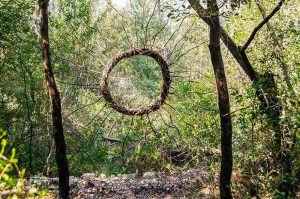 Loving attention allows feeling or thought to be in the field along with whatever self-care that is needed. We are all deserving of care. I invite you to give yourself kind attention. Time. Space. Presence. We may sense each other in the field of awareness. Abiding in the great field, we can know there is caring and being cared for. Take a breath or two to allow yourself to know this. You can allow any associations you have with caring, being cared for to surface in the field.
Loving attention allows feeling or thought to be in the field along with whatever self-care that is needed. We are all deserving of care. I invite you to give yourself kind attention. Time. Space. Presence. We may sense each other in the field of awareness. Abiding in the great field, we can know there is caring and being cared for. Take a breath or two to allow yourself to know this. You can allow any associations you have with caring, being cared for to surface in the field.

